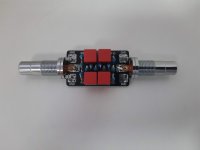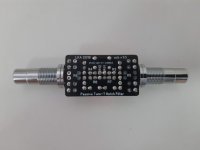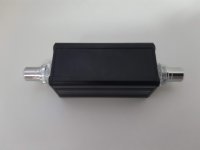Never tried an active notch. I don't believe them. It’s hard to imagine that an active notch can distort less than passive one.
Why do you use an active buffer stage? I remember seeing your measurement chain you had posted a few posts back, with photos. I think there was an active buffer in that chain.
The buffer was (would be) the ideal location for the LME49990. That change in my Shibasoku's made a big difference on the active notch filters. if the impedance is low then you get a benefit. The lower noise and distortion can shine. Unfortunately the LME49990 did not survive and the $$$$$$ for a new mask set cannot be justified.
The OPA1611 is similar but not quite as good it seems. The LME49990 had a GBW of 110 MHz which does make a difference at higher frequencies. However its large input transistors are not compatible with Victors oscillator. Both noise and a tendency to oscillate in higher Z circuits.
LME49720/LM4562... min 125 dB
OPA1656 ... min 134 dB
Of course, the OPA1656 is very good candidate for the buffer amp after the passive notch, needs to try. The OPA627 runs well in this place. I can see only very small distortion contribution at 10 kHz. Now I have also the discrete buffer which is better than OPA627 in terms of noise and distortion.
Did you have any luck with an active notch filter? Or was the distortion too high?
Never tried an active notch. I don't believe them. It’s hard to imagine that an active notch can distort less than passive one.
Well, the point for passive/active notch is the need of the input buffer to drive the T-Notch R/C circuit. Bootstrapped T-Notch will be the best active circuit (against TI paper) to choose the Q as the 2. Harmonic will not reduced as Q about 8..10.
This means, to lower the resistor noise a good input T-Notch driver is required f (THD & Noise & Level). I do not like to drive the LDO, as using balanced LDO connection, to have any influences/impact do the T-Notch load (none buffered). Active or none active behave here equal.
Also the used cap brand as resistor brand will be important. Any resistor pot's to tune up, will degrade the notch over time. Also I do not like to use any dual opamps, do the channel cross talk.
Hp
The active linear buffer is located after the passive notch filter for to amplify the distortion signal.Why do you use an active buffer stage? I remember seeing your measurement chain you had posted a few posts back, with photos. I think there was an active buffer in that chain.
Ah. Thanks. Understood.The active linear buffer is located after the passive notch filter for to amplify the distortion signal.
LME49720/LM4562... min 125 dB
OPA1656 ... min 134 dB
Of course, the OPA1656 is very good candidate for the buffer amp after the passive notch, needs to try. The OPA627 runs well in this place. I can see only very small distortion contribution at 10 kHz. Now I have also the discrete buffer which is better than OPA627 in terms of noise and distortion.
OPA627 is a DC precision op amp, not for audio. ???
A very simple way to test for oscillations, if you don't have a scope, is using what hams call a detector probe.
It consists of a small-signal diode like the 1N4148 and a small capacitor, like 100pF. The capacitor is connected with one end to the point you want to test, like an opamp output. The other end of the cap goes to the K of the diode, the A of the diode goes to ground. Measure with a DC ultimeter across the diode for DC. If there is DC, the circuit oscillates.
Jan
I'm guessing this might work better if a Schottky diode is used, due to its lower forward voltage.
Cheers,
Bob
Yes. Ed Simon mentioned some vintage 'RF hot carrier diodes' which are just Schottkys of course.
Jan
Jan
The trouble, or maybe not, is schottkey diode have much larger junction capacitance which may interfere.
Current version of Hot Carrier Diodes!
https://www.onsemi.com/pub/Collateral/MMDL301T1-D.PDF
Use a biased pair and look at the difference between the one with added RF and the dry one. You can detect well below a millivolt of RF.
They might even be popular, Digikey has more than 100,000 in stock! But it will run a bit more than $10.00 for a hundred.
https://www.onsemi.com/pub/Collateral/MMDL301T1-D.PDF
Use a biased pair and look at the difference between the one with added RF and the dry one. You can detect well below a millivolt of RF.
They might even be popular, Digikey has more than 100,000 in stock! But it will run a bit more than $10.00 for a hundred.
Last edited:
Please look in the OPA627 data sheet:OPA627 is a DC precision op amp, not for audio. ???
Applications-
Precision Instrumentation
Fast Data Acquisition
DAC Output Amplifier
Optoelectronics
Sonar, Ultrasound
High-Impedance Sensor Amps
High-Performance Audio Circuitry
Active Filters
Very nice Simon, thanks. Now if only the USD would tank I can get back into electronics.
Got a lot of time on my hands for the few months.
Got a lot of time on my hands for the few months.
passive Twin-T notch filter
My passive 1K Twin-T notch filter based on Victor's schematic. (I got pcb yesterday, in evening assembled and measured)
Simulated depth 75dB, measured 58dB.
See attached document for more
My passive 1K Twin-T notch filter based on Victor's schematic. (I got pcb yesterday, in evening assembled and measured)
Simulated depth 75dB, measured 58dB.
See attached document for more
Attachments
Current version of Hot Carrier Diodes!
https://www.onsemi.com/pub/Collateral/MMDL301T1-D.PDF
Use a biased pair and look at the difference between the one with added RF and the dry one. You can detect well below a millivolt of RF.
They might even be popular, Digikey has more than 100,000 in stock! But it will run a bit more than $10.00 for a hundred.
Maybe this could be turned into a Group project, an Oscillations Sniffer.
Ed, how does the actual circuit look then, can't visualize it well.
Jan
- Home
- Design & Build
- Equipment & Tools
- Low-distortion Audio-range Oscillator


